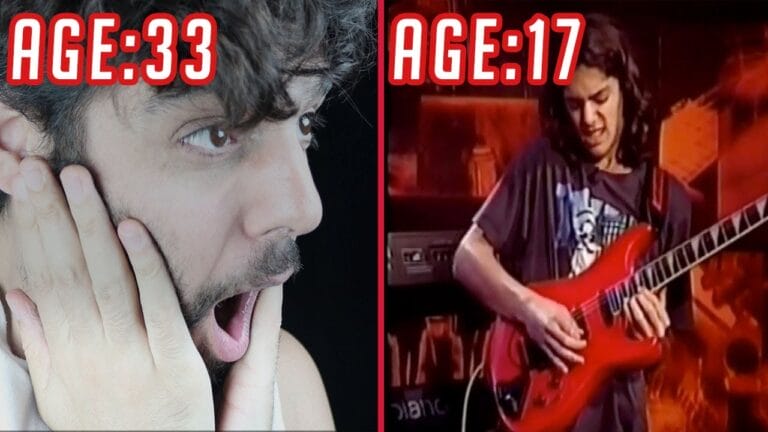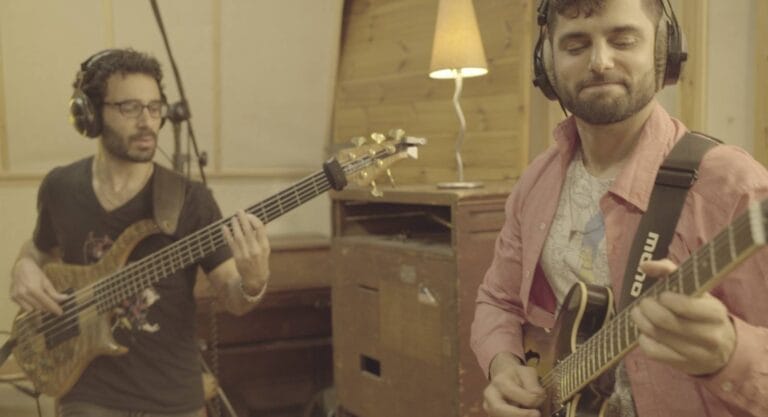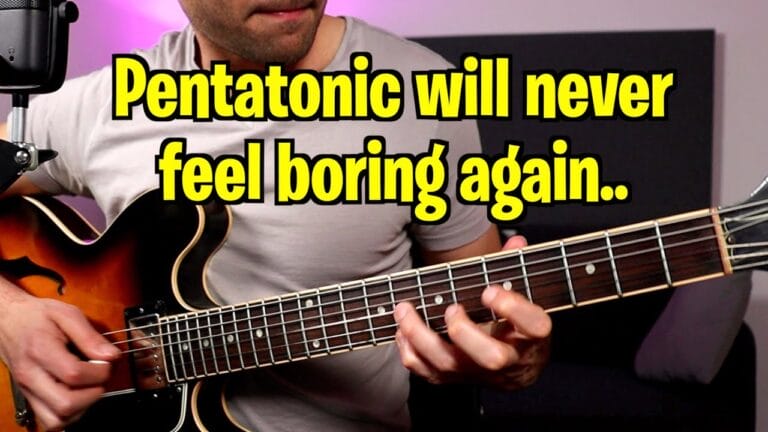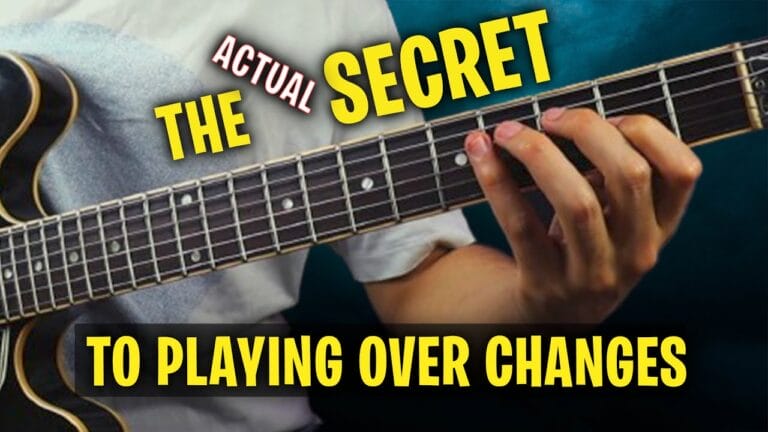How to solo with Arpeggios – The Super Effective Way
[Music]
So in this video I’m going to show you the one practice that absolutely changed everything for me when it comes to connecting my ideas on the fretboard, especially when you have a bunch of chord changes and you want to keep the flow going.
Concept Overview
Here’s what we’re gonna do: we’re gonna take a piece of music, a standard that you might know if you’re into jazz, especially, and it’s called “All the Things You Are.”
“All the Things You Are” is built out of a 6 2 5 1 4 progression, and then there is a modulation up two steps. So in this case, we’re starting off in A flat and then we’re modulating two steps above to C.
So the chords are going to be:
- F minor
- B flat minor
- E flat
- A flat
- D flat
- G7
- C major seven
What we’re gonna do is take this position right here, and I’m gonna show you the arpeggios one by one. Then we’re gonna connect them and even make them into an actual improvisation concept.
F Minor Seven Arpeggio
The first arpeggio is F minor seven. As we said, we’re going to restrict ourselves to stay in one position, this third position over here.
With our second finger, we’re going to play this A flat, which is the flat third, and then we’re gonna move to the five, then playing the seventh, and then the root. So we already have a full octave.
In F minor seven, our first chord, this is the flat 3, 5, 7, root. And then we’re going to keep building up our arpeggio within that position now.
Something very important is to be able to see octaves on the guitar. I can see that this is my next flat third because I know my octaves. You see, as I see this flat third, it’s reflecting visualization-wise on my next flat third.
So I get this: flat 3, 5, 7, root, flat 3, 5, 7, root, flat 3.
[Music]
B Flat Minor Seven Arpeggio
Now, my next arpeggio is going to be B flat minor seven. So that is going to bring me into this note again, but this time this note is going to be the flat seven of B flat minor seven.
So I’m getting a flat seven, a step above will be my root, and then I can see my triad over here. So, flat seven, root, three (here’s my minor third), my fifth. This is my triad.
Flat seven, I can see that this is a flat seven because I know how octaves look on the guitar. Here’s another way of seeing octaves: you see, this is also an octave.
So a step below my octave would be my flat seven. I can make flat seven, root, flat three, five. Flat seven, root, flat three, here’s my minor third, five. And whatever happens on the low E string happens on the high E string. So here we go: that’s my flat seven to my root again.
[Music]
E Flat Seven Arpeggio
Okay, next arpeggio is going to be E flat seven. Staying in the position, I’m gonna get my third over here.
So I have third, five, then flat seven, root. Then again, third, five, flat seven, root. Here’s my octave again. Keep visualizing those octaves; being able to see octaves is a game changer. Then you can see that whatever happens on the low E string also happens on the high E string.
So I get this E flat seven arpeggio.
A Flat Major Seven Arpeggio
Then moving into my one chord, my tonic, this is actually going to be now my major seven because it’s the major seven of A flat.
So I get major seven, root of A flat, then major third, five. Major seven again. How do I know that this is a major seven? Well, there are many ways to know. One way would be to recognize again, visualizing an octave but seeing that a half step below that octave is my major seven.
Major seven, root, third, five, major seven, root, third, five. I know that this is my third and five because I know my triads. It’s very important to learn triads and you can really go deep into triad and arpeggios on my website weissguitar.com. You can check out the link in the description for Galactic Modern Guitar.
So you get root, third, five, then again major seven to the root. That’s what is happening over there because whatever happens on the low E string happens on the high E string exactly. So major seven, root, third, five, major seven, root, third, five, major seven, root.
D Flat Major Seven Arpeggio
Now this note, on my next chord D flat, it’s gonna be the five of D flat. So I get five, major seven, root, third, five, major seven, root, third, five. Here’s my triad again.
Always build on your awareness of triads. It’s very important to know triads when it comes to guitar, arpeggios, scales—all those are the fundamentals that you learn and practice so later you can just express yourself because they are the building blocks of the language of music.
So, five, major seven, root, third, five, major seven, root, third, five.
G7 Arpeggio
Now for our next chord, G7, I’m going to do something special, which is altering the notes. Instead of having a five, I want to put a sharp five in there because it’s a really beautiful thing to do over dominant chords. Change the five, maybe lower it or raise it. It’s from the altered scale, which is a whole other subject that you can check out also on this channel.
So let’s go into it. Root—so now this is the root. I’m still staying in a position right: root, third, sharp five. This is like an augmented sound because it’s actually an augmented triad over here. You see, it’s all major thirds. And then flat seven.
Once again, here’s the visualization of the octave. Here’s my flat seven. So I get root, third, sharp five, seven. Root, third, sharp five, my augmented triad, seven, root, third. Let’s build it.
C Major Seven Arpeggio
And now I can resolve it into my new tonic, which is C major.
So here’s C major seven. This time this is going to be the five of C. Then the seven, major seven, root, third, five, major seven, root, third, five, major seven.
So I get this.
[Music]
Connecting Arpeggios
So now we have our arpeggios, right? Well, the next step is going to connect them. We’re going to stay in that one position, so I’m going to do this right now and you can practice along. Feel free to rewind or slow down this video. I want you to get this.
Okay, so here we go:
F minor seven.
I’m gonna come back in my next arpeggio, which is B flat minor seven.
[Music]
Now I’m going to go up in A flat seven, my next chord.
[Music]
And now I’m going to come back in my tonic, A flat major seven.
[Music]
Now I’m going to go up in D flat major seven, which is my next chord, fourth degree.
[Applause]
And I’m going to come back in G7 sharp five.
[Music]
And I’m gonna come up in C major seven.
So now I’m gonna do this within time: two, three, four.
[Music]
[Applause]
You can do it in many variations; this was just an example of one way you can start connecting these. What I’m gonna do now is kind of improvise my way within these arpeggios using not only chromatics when I feel like enclosures, which I also, by the way, talk about in this channel. So make sure to subscribe and check out the other videos.
I’m going to also start connecting some other movements around those arpeggios to connect them. So it’s not like I’m thinking about one arpeggio after the other; it’s more like I’m kind of seeing my note possibilities and kind of drawing between the lines and connecting them.
Let me show you what I mean: one, two, three, four.
[Music]
More Examples
Okay, more examples: one, two, three.
[Music]
I’m kind of more thinking about the rhythm than anything else. But because I took the time to connect those arpeggios, now I can kind of just think about the rhythm and think about the connecting areas.
[Music]
So what you can start seeing is that you can start approaching into these arpeggios. For example, going into this F minor 7, I can go then playing the structure that gives you actually also the 9 of the arpeggio. So playing an F minor 7 add 9 sound.
[Music]
Then maybe reversing that arpeggio into B flat minor 7 through this. So this is third, second, root. So I’m adding a lot of seconds in there. Seconds and nines are the same stuff.
That’s an example.
[Music]
Then I can aim into the third, so I’m thinking ahead. I can aim into the third of the E flat seven arpeggio. This third right here, I can go kind of like enclosuring that note.
[Music]
Solo With Arpeggios
knowing the theory is basic,
however knowing how to apply it into your music is quite another thing.
Arpeggios are basic in music and naturally in creating solos. However it is not that clear to so many how to really pull it off. I know I struggled with this for a while until I discovered what I am showing you in this video lesson.
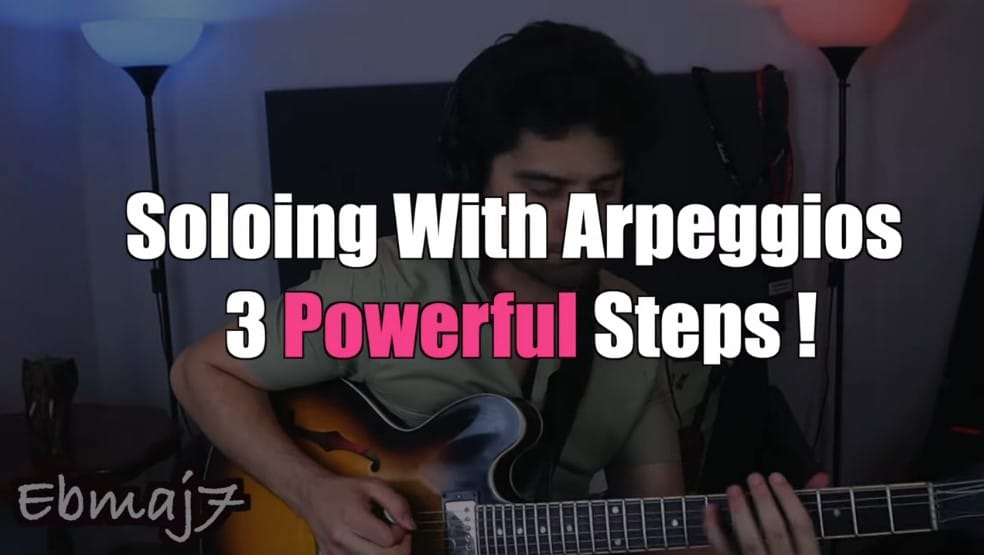
In this video lesson you’ll discover a super effective arpeggio workout.
Furthermore, you will learn how to solo with arpeggios and create your own Improvisations using it.
You’ll also see how I’ve been putting that control into actual musical phrases.
Study and practice these examples until they become habits and apply them into your own playing, tunes, and jams.
You’ll be improvising like a pro!










